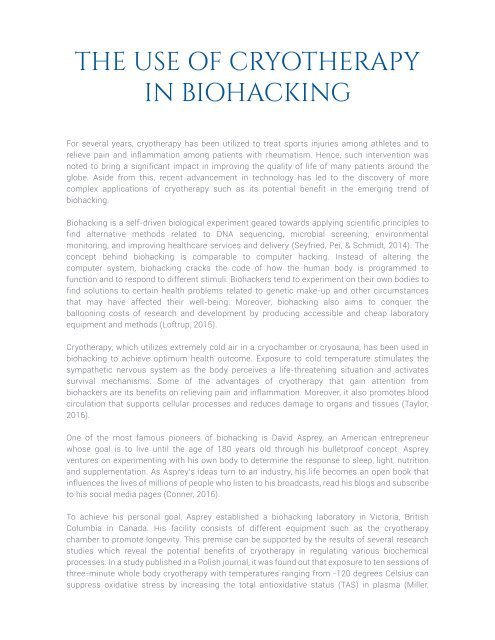BROCHURE Scientific-Studies-Cryotherapy
You also want an ePaper? Increase the reach of your titles
YUMPU automatically turns print PDFs into web optimized ePapers that Google loves.
THE USE OF CRYOTHERAPY<br />
IN BIOHACKING<br />
For several years, cryotherapy has been utilized to treat sports injuries among athletes and to<br />
relieve pain and inflammation among patients with rheumatism. Hence, such intervention was<br />
noted to bring a significant impact in improving the quality of life of many patients around the<br />
globe. Aside from this, recent advancement in technology has led to the discovery of more<br />
complex applications of cryotherapy such as its potential benefit in the emerging trend of<br />
biohacking.<br />
Biohacking is a self-driven biological experiment geared towards applying scientific principles to<br />
find alternative methods related to DNA sequencing, microbial screening, environmental<br />
monitoring, and improving healthcare services and delivery (Seyfried, Pei, & Schmidt, 2014). The<br />
concept behind biohacking is comparable to computer hacking. Instead of altering the<br />
computer system, biohacking cracks the code of how the human body is programmed to<br />
function and to respond to different stimuli. Biohackers tend to experiment on their own bodies to<br />
find solutions to certain health problems related to genetic make-up and other circumstances<br />
that may have affected their well-being. Moreover, biohacking also aims to conquer the<br />
ballooning costs of research and development by producing accessible and cheap laboratory<br />
equipment and methods (Loftrup, 2015).<br />
<strong>Cryotherapy</strong>, which utilizes extremely cold air in a cryochamber or cryosauna, has been used in<br />
biohacking to achieve optimum health outcome. Exposure to cold temperature stimulates the<br />
sympathetic nervous system as the body perceives a life-threatening situation and activates<br />
survival mechanisms. Some of the advantages of cryotherapy that gain attention from<br />
biohackers are its benefits on relieving pain and inflammation. Moreover, it also promotes blood<br />
circulation that supports cellular processes and reduces damage to organs and tissues (Taylor,<br />
2016).<br />
One of the most famous pioneers of biohacking is David Asprey, an American entrepreneur<br />
whose goal is to live until the age of 180 years old through his bulletproof concept. Asprey<br />
ventures on experimenting with his own body to determine the response to sleep, light, nutrition<br />
and supplementation. As Asprey’s ideas turn to an industry, his life becomes an open book that<br />
influences the lives of millions of people who listen to his broadcasts, read his blogs and subscribe<br />
to his social media pages (Conner, 2016).<br />
To achieve his personal goal, Asprey established a biohacking laboratory in Victoria, British<br />
Columbia in Canada. His facility consists of different equipment such as the cryotherapy<br />
chamber to promote longevity. This premise can be supported by the results of several research<br />
studies which reveal the potential benefits of cryotherapy in regulating various biochemical<br />
processes. In a study published in a Polish journal, it was found out that exposure to ten sessions of<br />
three-minute whole body cryotherapy with temperatures ranging from -120 degrees Celsius can<br />
suppress oxidative stress by increasing the total antioxidative status (TAS) in plasma (Miller,



